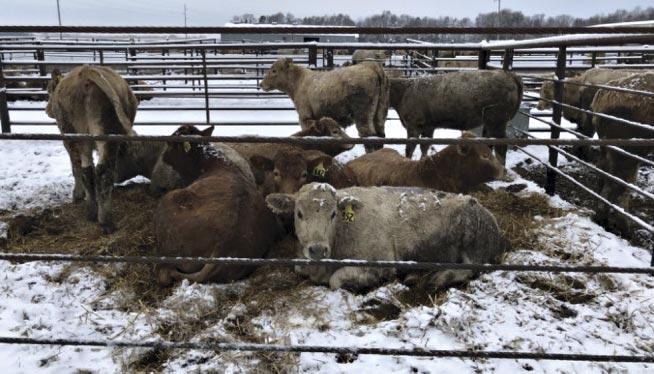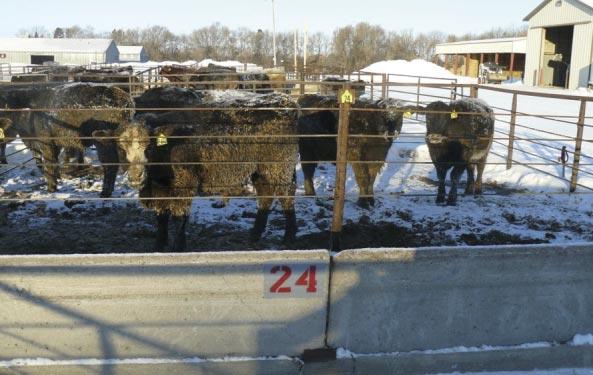
5 minute read
Steers Fed at a Northern Latitude
By Zachary Smith, Ph.D., Department of Animal Science, South Dakota State University, Brookings, SD
Three important factors that influence the profitability of a cattle-feeding enterprise include: 1) an abundant supply of feeder cattle, 2) readily available and economically priced feed resources, and 3) a favorable production environment. For example, in South Dakota, we are fortunate to be close to an abundance of quality feeder cattle and feedstuffs. Obviously, South Dakota got the short end of the stick in regards to wintertime weather conditions. Challenges to cattle and their caretakers in the wintertime include cold temperatures, wind, snow, and freezing rain, all of which result in undesirable pen surface and working conditions. Average wintertime conditions in the Northern Plains region range from 10 to 35°F.

Cattle producers are, however, forward thinkers, adaptable, and readily resourceful. Early settlers to this region used shelterbelts to protect their homesteads from relentless wintertime conditions. For producers without mature and well-established shelterbelts, the use of wind fencing is common in feed yards in the northern regions of North America. Crop residues such as corn stalks and straw are commonly used as bedding material in the Northern Plains (same products others consider a feedstuff further south). Lastly, many producers in the Northern Plains region elect to feed cattle throughout the entire year in enclosed barns. All of the aforementioned mitigation strategies have their advantages and disadvantages. For example, what is useful in the wintertime (e.g., a shelterbelt or wind fencing) might prove problematic come summertime (e.g., no wind movement across the yard).
Undesirable pen conditions observed during wintertime can negatively impact the insulative capacity of cattle hair coat as a result of dampness and mud or manure accumulation. For cattle, the insulative capacity of the hair coat is a contributing factor to their lower critical temperature (LCT) threshold. The LCT for all homeotherms is the temperature below which the organism’s metabolic rate must increase in order to maintain homeothermy. The maintenance requirement of an animal is an estimate of the amount of energy necessary to keep an animal in an equilibrium state. Temperatures falling below the lower critical temperature for cattle with a dry, heavy winter coat (18°F) will result in an increase in maintenance requirements, and due to this diversion of energy toward maintenance function, a resulting decrease in feed available for gain and productive function is observed through decreased performance.
Bedding application as a means to improve cattle comfort during wintertime has been commonplace for Northern Plains cattle producers for many years. However, the exact degree to which bedding application improves growth performance has not been well established. As such, three experiments were conducted at the Ruminant Nutrition Center in Brookings, South Dakota, from January to March (yearling steers, initial 36 day receiving period, Exp. 1), January to July of 2019 (yearling steers, cumulative finishing period, Exp. 2), and October to December of 2019 (bawling steer calves, initial 56 day receiving period, Exp. 3). In Exp. 1 and 2, steers received 4 lbs (as-is basis)/steer·d-1 of wheat straw bedding, and in Exp. 3, steers received 2 lbs (as-is basis)/steer·d-1 wheat straw bedding. The goal of bedding application was to ensure that all steers within a bedded pen had a dry spot to lay down at all times during the course of the experiment. The average ambient temperature and the average wind chill was 5.2°F and -0.3°F in Exp. 1, 39.8°F and 37.3°F in Exp. 2, and 26.5°F and 22.8°F in Exp. 3.
In Exp. 1, steers from the bedded treatment had increased body weight on day 36 by 4.2%, increased average daily gain by 48.0%, improved feed conversion by 74.4%, and a decreased estimated metabolic rate by 40.8% compared to non-bedded steers. In Exp. 2, steers from the bedded treatment had increased average daily gain by 21.0%, greater dry matter intake by 5.9%, improved feed conversion by 14.6%, a decreased estimated metabolic rate by 10.6%, and required 35 fewer days on feed to reach an industry acceptable level of rib fat compared to non-bedded steers. In Exp. 3, steers from the non-bedded treatment had 4.6% greater dry matter intake, an increased estimated metabolic rate by 18.2%, and similar average daily gain at the end of the 56 day receiving period, that translated into an improved feed conversion rate of 5.6% for bedded steers compared to non-bedded steers.
Based upon the value of body weight gain and cost of body weight gain, we can assess the value of bedding application (Table 1; extreme wintertime cold stress). The following examples will include 3 different types of bedding with varying costs applied at a rate of 4 lbs (as-is basis)/head·d -1 : 1) corn stalks (30.00 $/ton), 2) wheat straw (70.00 $/ton), or 3) wheat straw (145.00 $/ton). Assumptions include: 1) initial body weight of 1000 lbs, 2) 60 day feeding period, 3) value of body weight gain of 0.80 $/lb, 4) a 64 Mcal/cwt NEg diet priced at 180.00 $/ton (dry matter basis), 5) same dry matter intake between bedded and non-bedded groups, 6) increased net energy for maintenance requirement of 34% for bedded cattle and 88% increase for non-bedded cattle, 7) yardage of 0.35 $/head·d-1, 8) estimated loader cost of 72.50 $/hour (loader cost of 0.07 $/head·d-1), 9) estimated labor time of 1 hour/week for a 150 head pen (labor cost not included), and the bedding cost of 0.06 $/head·d -1 for corn stalks, 0.14 $/ head·d -1 for the less expensive wheat straw, and 0.29 $/ head·d -1 for the expensive wheat straw. The in and out cost for corn stalks is 0.129 $/head·d -1 , 0.209 $/head·d -1 for the less expensive wheat straw, and 0.359 $/head·d-1 for the more expensive wheat straw. Thus, the return on investment (ROI) for corn stalks was 6.3 to 1, for less expensive wheat straw ROI was 3.9 to 1, and for the more expensive wheat straw ROI was 2.3 to 1.
Another example can be used where all assumptions remain the same except that assumption 2 is changed to a 120 day feeding period, assumption 5 is changed to reduced intake of 5.5% for non-bedded, and assumption 6 is changed to a 26% increase in metabolic rate for bedded cattle and a 42% increase in metabolic rate for non-bedded cattle (Table 2; normal wintertime cold stress). The in and out daily cost does not change from above for daily labor or bedding cost. In this second example, ROI is 1.7 to 1 for the corn stalks, 1.3 to 1 for the less expensive wheat straw, and 0.9 to 1 for the expensive wheat straw. This second example suggests that even if the wintertime conditions are not severe (much like the alterations in metabolic rate seen in Exp. 2), the ROI for bedding is more nearly a breakeven proposition.
A key point here is that one will likely incur the cost associated with bedding cattle no matter what they choose to do (i.e., the extra 35 days of yardage and feed costs for the non-bedded steers in Exp. 2). Even if the ROI for bedding is not large, the steers from Exp. 2 took an extra 35 days to achieve a marketable end body weight compared to the bedded steers. Another factor to consider for an integrated crop-livestock business is the nutrient value of the crop residue will be returned to cropland as part of the manure, reducing the net cost of the bedding compared to these examples. There are also less tangible but still important benefits to bedding that should be considered such as enhanced visual appeal of cattle to be sold as backgrounded feeders and improvements in overall cattle comfort and welfare.

These data indicate that enhancements of growth performance for bedded steers compared to non-bedded steers were not solely attributable to increased dry matter intake but rather to an amelioration of cold stress on maintenance energy requirement. In conclusion, bedding application should be considered as a risk reduction strategy during wintertime feeding to improve feed conversion efficiency by reducing maintenance energy requirements in beef steers during the feedlot production phase.
















